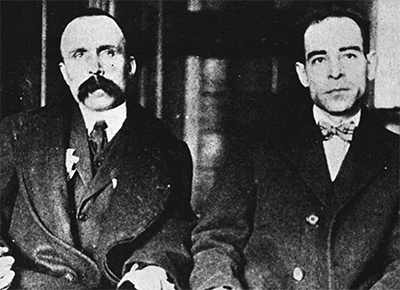“If it had not been for these things, I might have live out my life talking at street corners to scorning men. I might have die, unmarked, unknown, a failure. Now we are not a failure. This our career and our triumph. Never in our full life could we hope to do such work for tolerance, for justice, for man’s understanding of man as now we do by accident. Our words – our lives – our pain – nothing! The taking of our lives – lives of a good shoemaker and a poor fish peddler – all! That last moment belongs to us – that agony is our triumph” – Letter of Bartolome Vanzetti (1888-1927) to Judge Webster Thayer who had condemned Vanzetti and Nicola Sacco (1891-1927) to death for the murder of a guard and the paymaster of the Slater and Morill Shoe Company in Braintree, Massachusetts on 15 April 1920.

Sacco and Vanzetti, along with a third member of the Italian anarchist group involved in the robbery were electricuted at midnight on 23 August 1927, after seven years of legal procedings and an organized social campaign to prevent the execution led by some of the leading intellectuals of the time, especially the novelist John Dos Passos. Some 200,000 persons attended the funeral, and there were demonstration in front of U.S. embacies in many parts of Europe. Since then, Sacco and Vanzetti have been symbolic figures in efforts to abolish the death penalty.
Two aspects of the trials and legal procedures have stood out in the anti-death penalty debates. The first is that it is often difficult to have a trial that is not influenced by emotions and the political currents of the times.
Both Sacco and Vanzetti had been members of an anarchist network led by the Italian anarchist writer Luigi Galleani who was living for some years in the New York area. He edited a journal calling for violent revolution. He was deported to Italy in June 1919, but his journal continued for several years after that. In the minds of many in the U.S.A. there was a link between anarchy and Bolshevism which had just come to power in Russia in 1917. There were fears that Bolshevism would spread. Moreover, both Sacco and Vanzetti had left for Mexico in 1917 and changed their names to evade draft registration which had been introduced in 1917 when the U.S. jointed the First World War. The prosecutor in the murder trial used the Mexico flight to demonstrate their lack of patriotism. In Massachusetts, there was a general anti-Italian feeling, even if individuals were not anarchist but family-loving Roman Catholics.
The second element of the case used in anti-death penalty efforts is that people are executed who are later found to be not guilty of the crimes for which they were executed. Research on the case continued long after the executions. It is highly possible that Sacco was in fact involved in the robbery and may have used the weapon he had with him. Vanzetti was not involved but rounded up as a member of the same Italian anarchist group which had robbed the pay of other shoe companies as well.
Thus the possibility of a person from a minority group, of the lower class, at a time of fear and international violence being convicted and executed is higher than if a person is part of the majority, has money to get a good lawyer, and the world situation is calm.
Studies in a good number of countries indicate that the death penalty has little impact on the rate of violent crimes. Thus, the Association of World Citizens has worked with others, especially in the United Nations bodies for the abolition of the death penalty.
Since the end of World War II, there has been a gradual abolition of the death penalty. In some countries, executions have been suspended in practice but laws allowing executions remain. In other countries, there has been a legal abolition.The abolition of executions and the corresponding valuation of human life are necessary steps in the development of a just world society.
*******************************
Rene Wadlow, President, Association of World Citizens